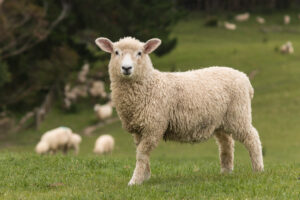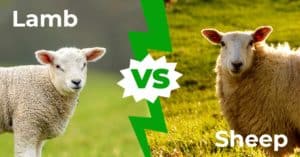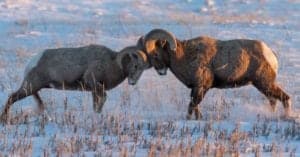If you’ve seen lambs and goats, you’ve probably observed some similarities. Both are often farm animals, both have hooves, and they have similar diets. They even look somewhat similar. It follows, then, that you might ask, is a lamb a goat?
Are lambs and goats one and the same?

A lamb is a baby sheep, while a goat is a goat of any age.
©iStock.com/Filip_Krstic
The short answer is no, lambs are not goats. A lamb is actually a baby sheep, while a goat is a different type of animal and a goat of any age. It’s kind of like comparing a human child to a chimpanzee!
Sheep and goats are somewhat related. They are both members of the same family (Bovidae) and subfamily (Caprinae). However, they are two separate genera; sheep are of the Ovis genus, and goats are Capra. Each of these genera includes many species; there are over 200 species of sheep and over 300 species of goats.
What is a lamb?
A lamb is a baby sheep, usually under one year old. A lamb will either grow into an adult male, called a ram, or an adult female, called a ewe. An adult sheep can weigh anywhere from 80 to 400 pounds; lambs are smaller than this, as they are still growing.
Even though the two animals are in the same family, the sheep is usually noticeably stockier than the goat. Wild species of sheep generally have hairy outer coats, along with a short undercoat of fine wool. In domesticated sheep, this fine wool has been developed into fleece that is harvested annually. Sheep also have scent glands in their faces and hind feet.
Sheep regurgitate their food and then chew the cud. This allows their four separate stomach compartments to undergo thorough digestion. These animals generally eat legumes and grass. When grazing, they will eat a plant closer to the root than most cattle. This means that someone managing a flock of sheep needs to watch out for overgrazing.
What are the differences between lambs and goats?
The main difference between a lamb and a goat involves age. A lamb is a baby sheep, while a goat is a goat of any age (although “kid” is the term for a baby goat). Lambs look much younger than older sheep, while it can be difficult to tell how old a goat is based on observation alone. Beyond this, it would make more sense to talk about the differences between sheep and goats.
In particular, goats are often confused with rams (male sheep).
Outer hair
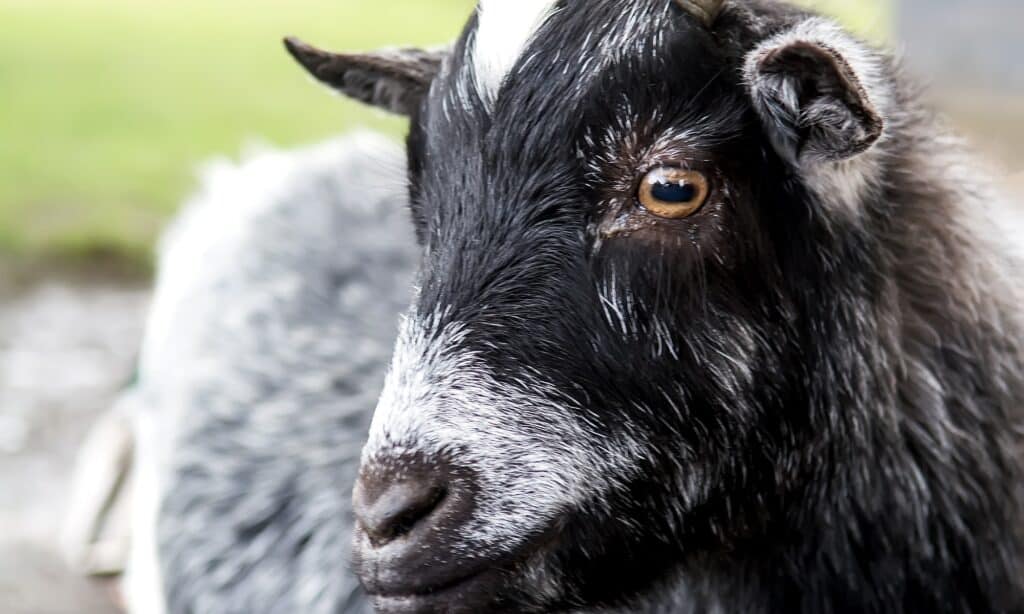
Sheep produce wool, while goat hair is not used for commercial purposes.
©iStock.com/alisa24
Most people know that sheep are the source of wool. They are sheared on an annual basis for it. Goats generally have hair, and they don’t require haircuts. Goat hair also is not used for commercial purposes. A lamb is just starting to grow wool. It will generally not have a thick enough coat for shearing until it reaches adulthood.
Goat hair is coarse and can either be short or long, depending on the species or individual. In contrast, wool is typically soft and dense. Lambs have thinner and shorter wool than adult sheep. The best quality wool comes from sheep that are between three and five years old.
Both sheep and goats are raised for farm purposes, including for food, but only sheep are raised for fleece.
Tail
One easy way to tell the difference between sheep and goats is their tails. The tail of a sheep usually hangs down, while that of a goat usually points upwards. A sheep’s tail is also generally thicker than a goat’s tail. Also, lambs often have docked tails; this is done at a young age for the health and safety of the animal.
Horns
Another difference between sheep and goats is that lambs are never born with horns, while goats can be. Some sheep can grow horns at some point in their lives, but this happens well into adulthood.
Most goats do have horns, while most sheep do not. In the cases when lambs do grow up and grow horns, they won’t look like goat horns. Sheep tend to grow horns on the sides of their heads, while goat horns are on the top. Sheep horns also tend to be somewhat round, looping around the sides of their heads, and goat horns are more likely to be straighter and pointy.
Lips and beards
Sheep do not have beards, while some goats do (particularly male goats). Sheep sometimes have manes instead. The upper lip of a sheep is divided by a philtrum, which goats do not have.
Personality
Sheep have very strong flocking instincts and tend to become anxious when dealing with separation from their flock. In contrast, goats tend to be more independent and curious. Because of this, goats are more likely than sheep to be natural troublemakers.
Eating habits

Sheep and goats find food in different ways; sheep are grazers, and goats are browsers.
©David Kay/Shutterstock.com
A major difference between sheep and goats is the way they forage. Sheep are grazers, meaning that they move slowly and tend to eat short plants that grow close to the ground. Goats, by contrast, are browsers. They look around for food, which usually comes in the form of shrubs, leaves, twigs, and vines.
Goats are more likely to explore and investigate, interacting a lot with the environment and using their agility and climbing abilities to find the foods that fit their diverse diets. They often end up in very interesting positions while doing this!
Can lambs and goats interbreed?
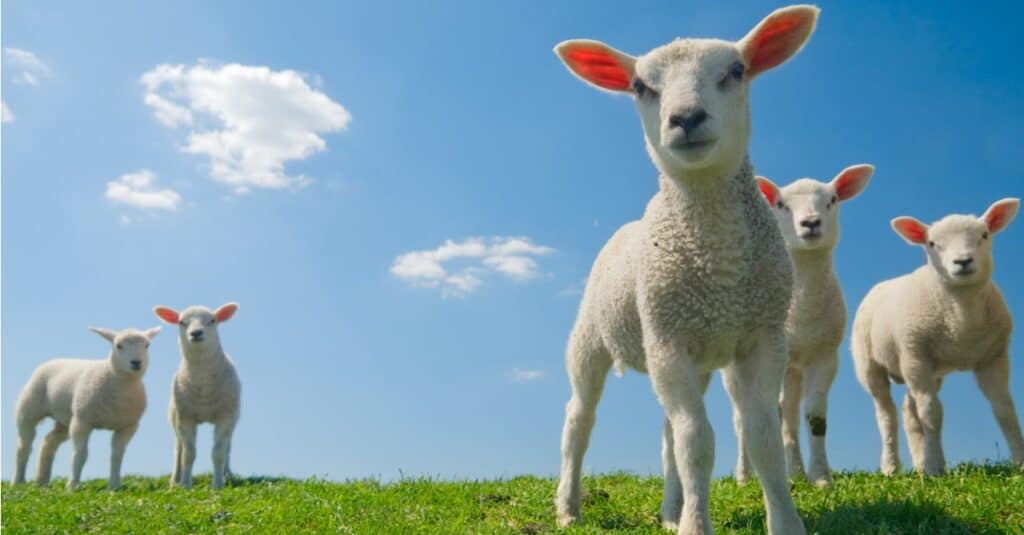
Sheep and goats can interbreed, but they are rare and often not healthy when they are born.
©iStock.com/Enjoylife2
A sheep has 54 chromosomes, while a goat has 60. It is actually possible to create a sheep-goat hybrid (people call them geep or shoats!), but these are rare. Most of the time, these hybrids die as embryos; even if they are born, they’re generally stillborn.
However, there are alleged cases of sheep-goat hybrids that survived. In 2000, at the Botswana Ministry of Agriculture, a live male offspring was born to a female goat (impregnated by a male sheep). The hybrid had a woolly inner coat and coarse outer coat, along with the thick body of a sheep and the long legs of a goat. Despite being sterile, he had a very high libido.
In the documented cases of sheep-goat hybrids, generally the males are sterile, and the females tend to experience complications with their own pregnancies. These individuals also tend to have 57 chromosomes, intermediate between the chromosome numbers for sheep and goats.
The photo featured at the top of this post is ©
Thank you for reading! Have some feedback for us? Contact the AZ Animals editorial team.



